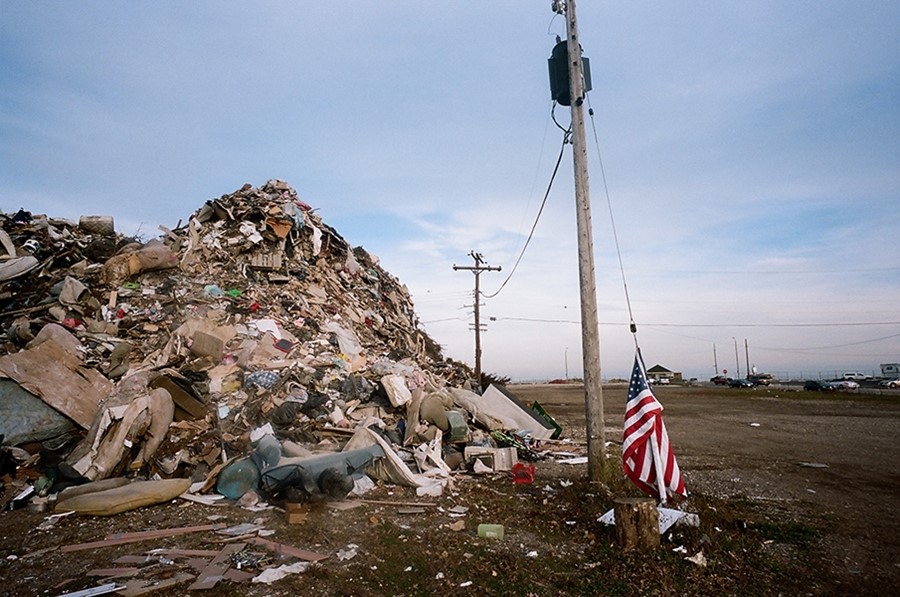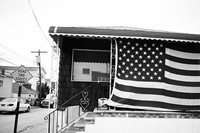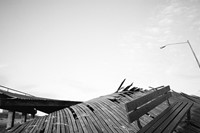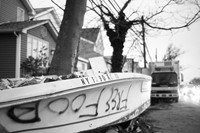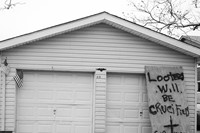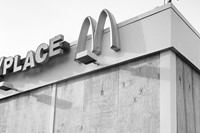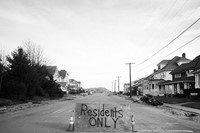On October 29 2012, the intransigent surge of Hurricane Sandy hit New York City, flooding streets, tunnels and subway lines and cutting power in and around the city. Photographer and filmmaker Cheryl Dunn, New York native and resident...
On October 29 2012, the intransigent surge of Hurricane Sandy hit New York City, flooding streets, tunnels and subway lines and cutting power in and around the city. Photographer and filmmaker Cheryl Dunn, New York native and resident, spent the night of the storm and its aftermath involved in the relief effort, running supplies to some of the worse hit areas, and using her camera to record the extraordinary destruction wreaked on her city.
Here she gives an exclusive account of the night itself and the days that followed Sandy’s sweep, accompanied by a series of photographs, titled "She Swallowed It", taken at the time. Her images, and the story she tells, convey the indescribable strangeness of this great metropolis having being pushed to its knees by nature, and depict the primal need for symbolism – be it patriotic, religious, or simply personal – and basic communication that is so essential to humanity’s survival when stretched to its limits.
"My apartment was in a very flooded area. The night of the storm, I helped my landlord and my neighbour deal with the sea water gushing up from the ground and drains into their homes. It was very dangerous outside with glass windows falling out of buildings, trees tumbling and rushing water waist high at the end of my street, all in complete darkness. It wasn't until the following day that I left my neighborhood to ride my bike around lower Manhattan. Thirty or so giant sycamore trees were just blown over on the East River – it looked like the Land of the Lost. In the ensuing days, we tried to help friends, and guard my husband's production company that was broken into on the night of the storm. We stood guard with bats and whiskey until the electricity came on four days later.
Communication was reduced to word of mouth. No phones, no radio, no internet, so it wasn't until a few days later that I found out what happened to Chelsea and the boroughs. The following week, my production company started doing daily volunteer runs, first going to the Rockaways. As we drove from Queens and over the Cross Bay Boulevard, the destruction was crazy: boats on the highway that had spray painted messages, giant signs...what struck me so much was the base level of communication that was being used. Signs and symbols, spray paint on boards, cars, and houses, and flags everywhere – giant ones, small ones, on everything. Since I have spent many years documenting graffiti, this notion was very compelling to me. Here was spray paint being used as a very direct and basic tool of communication even in the affluent community of Deal, New Jersey.
"The boardwalks had been blown off, snapped and twisted around. They looked like giant zippers laid on top of each other as if snaking down the beach...destruction can sometimes be so eerily beautiful"
After the first day of volunteering, as we drove back to Manhattan, I stopped to take a picture of that boat on the highway. We walked down a road to see more wreckage. Boats, cars that had formerly been filled up with weeds and dirt now totally submerged, and houses half collapsed with giant holes in the sides. We talked to a woman out walking her pit bull, and she relayed her storm tale. She had lived in this house all her life and did not evacuate, instead hunkering down with her husband , children, pit bulls and a big pot of zitti. When the storm hit, her house – already built on stilts – was submerged 12 feet. They stayed on the 2nd floor as boats from the adjacent marina kept smashing into the exterior of the house like battering rams. By morning the water level had gone down, but there they stayed without any news of the outside world for four days. Cars were wrecked, they had no food, and no water until days later, when a generous Indian man rolled up to the end their street with his car filled with home cooked food and water.
I went back to the Rockaways a few more times to bring supplies from the Bowery Mission in Manhattan to a church on Avenue 20 in far Rockaway. On these trips, I combed the area for more signs and symbols, like the McDonalds image, and the "Looters will be shot" picture. One afternoon at sunset I saw a guy emerging from the beach as I drove by and thought to check it out. I found a stretch of boardwalk here that was so spectacular looking – the boardwalks had been blown off, snapped and twisted around. They looked like giant zippers laid on top of each other as if snaking down the beach. This was one of those instances when you think how destruction can sometimes be eerily beautiful.
That Sunday, super early, I took a drive to Staten Island. a place where a lot of working class people live, alongside police and fireman. People here live in more modest houses, sometimes for generations. Flags were used to fill up holes in the side of houses. The "she swallowed it" graffiti was here, boarded up churches. I saw grown men crying on their front steps, so many ruined lives in this community. Ruined businesses. The people here were spray painting their cell phone numbers in numerals covering the whole side of their houses because the authorities said they were going to start knocking down houses if they couldn't find the owners..
The next day I drove to New Jersey where I grew up. I went to the beach towns where I used to go in high school. Sea Bright, a small town with an inter-coastal body of water on one side and the Atlantic on the other, was totally destroyed. The National Guard were there, the people were under curfew, it was bleak. This is where I came upon the giant mountain of garbage – a four storey pile of possessions and house bits, next to an identically sized pile of tree limbs, next to a pile of broken boards from the destroyed boardwalk. And yes, flags. Flags, flags, flags.
"I came upon the giant mountain of garbage – a four storey pile of possessions and house bits, next to an identically sized pile of tree limbs, next to a pile of broken boards from the destroyed boardwalk. And yes, flags. Flags, flags, flags"
The symbols of the cross and the flag are very American and always populate the visual landscape, but nothing like this. I must admit I stuck a little flag in a potted plant in my front window and I don't even know why I did it really. The whole idea of communication, in a void of technology, in 2012 New York City is strange. We were reduced to relying on word of mouth for information, story telling, and in turn lore. Dealing with the immediate circumstances, whether that meant politely writing "Residents Only", or defensively scrawling "looters will be shot". It's all communicating the same thing, using the same tools. These are all things I contemplated while shooting these images."
Today is the launch of RE/CREATE New York, a charitable platform where creatives including Sarah Burton, Kate Moss, Christopher Bailey, Marc Jacobs and Jefferson Hack have donated an extraordinary range of items for auction, with all proceeds going to hurricane relief charity New York Cares.
